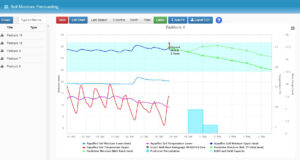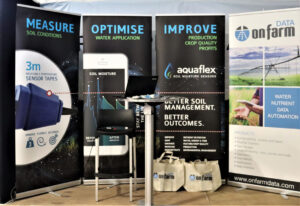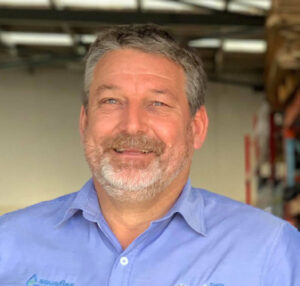Knowledge is power, and nowhere is this truer than in the need for precise data for irrigation in New Zealand. The limitations of the country’s freshwater supply, soil, and regulatory regime necessitate precise use of each drop of water. Accurate data also ensure the precise application of water and fertilizer and allow nutrients to be tracked and controlled to prevent contamination of water resources. Andrew Neill’s company, Onfarm Data, is an innovator in this space. Working with farmers, irrigators, and local regulators, Onfarm has supplied data that all parties use to maximize water and nutrient resources with minimal environmental impact. In this interview, Mr. Neill tells Irrigation Leader about his family’s deep roots in agriculture, how Onfarm Data’s products are making a difference in New Zealand, and how they can also help address water challenges in the United States.
Irrigation Leader: How long have you been with your company?
Andrew Neill: Onfarm Data Ltd was formed in June 2017. Originally, the control system was developed by Onfarm Solutions, but with the continuing focus on water and nutrient management and regulation, I joined the other directors to form a standalone company. Onfarm Solutions has been partnering with dairy farmers for 13 years, and its technology is focused on automation within dairy sheds. It has developed technologies such as the Teatwand Exact, Teatwand Stepover, and Teatwand Rapid, which are helping many U.S. customers. We focus on whole-of-farm systems for irrigation, fertigation, effluent management, data, and control. Today, Onfarm Data is based in Christchurch, on the South Island of New Zealand. Eighty-five percent of the consented water takes are within 160 kilometers (km), or about 100 miles (mi), of us.
Irrigation Leader: How long has your family been in New Zealand?
Andrew Neill: My forefathers were some of the first settlers to arrive in Christchurch. My parents were originally located around 15 km (9.3 mi) from Christchurch in Lincoln; they then moved to a small dairy farm 100 km (62 mi) further south. They milked 100 cows twice a day in an eight-bail walk-through system. I am one of 6 children; we are all still located on the South Island of New Zealand. Some of us are still in agriculture; my brother is a partner in a dairy farm in North Canterbury. He’s running 650 cows through a 60‑bail rotary, with water supplied for irrigation via a pressured pipe scheme with 2 wiper pivots and 500 solid-set sprinklers on poles. My sister farms on a dryland deer farm, and my father is semiretired on a small viticulture block just outside of Blenheim in Marlborough, where he grows Sauvignon Blanc grapes.

Irrigation Leader: How many employees does Onfarm Data have?
Andrew Neill: Onfarm Data currently has seven employees; however, we are part of a group of three companies that share resources. There are approximately 45 staff in the group. The other two companies are ATL and Onfarm Solutions. ATL is an electrical technology company that does everything from domestic, industrial, and commercial wiring to high-end automation, including sound systems or setting up homes with the latest technology for entertainment and home management systems. Onfarm Solutions focuses on farm solutions relating to automation and dairy sheds. It’s technology to reduce the operator’s workload and to provide consistent results day in and day out. Adding technology allows staff to be transferred to other positions that add more value to the farming operation. We share resources, including marketing, engineering, design, and IT, to get the best bang for our buck. All the directors are actively involved in each of the businesses where appropriate.
Irrigation Leader: What do you do for farmers with your technology?
Andrew Neill: New Zealand is compliance driven when it comes to water and nutrients, and it is only becoming more so. We provide technology to meet compliance and regulatory requirements, just as other service providers do. However, we look at it from the farmers’ perspective. We need to capture data around the farm, add data from others’ sources where applicable, and provide users with decisionmaking information. Once users have this at their fingertips on a smartphone, they can take action on those decisions via our One Centre Axis platform, which allows them to turn pumps and other equipment on and off. When we take this approach, the compliance and regulatory report requirements are a byproduct, so there is no additional cost. The users benefit from proactive decisionmaking based on accurate, real-time data relevant to their farms. We look at the users’ current and future needs and understand the incoming compliance and regulatory reporting. Our system is modular, so our users can start with what they need right now and add more modules as their systems and needs change.
Irrigation Leader: So you’re using the lemons of compliance requirements to make lemonade.
Andrew Neill: Yes, we are! The farmers have to do compliance work, so we ask what we can do to achieve those outcomes. One way is to collect good data. It sounds simple, but we have had a steep learning curve in New Zealand. In 2010, it was decided that every single water take, whether of surface water or groundwater, was going to be metered by a data logger making measurements every 15 minutes, every day of the year. Even now, some companies are struggling to get complete datasets, because some of the technology hasn’t been fit for purpose, and some service providers have not invested in the correct process and staff to understand technical and on-farm issues. We have learned that having correct and complete data is highly valuable. The data allow farmers to improve their processes and scientists to do modeling. This use of data means that valuable resources are being used in an effective and environmentally responsible way.
Irrigation Leader: Do you provide users with meters and data collection hardware in addition to the software?
Andrew Neill: We provide some of the farms with hardware. We don’t manufacture things like electromagnetic or mechanical flow meters, but we do manufacture our own telemetry and logger field units. They are sensor agnostic and will connect to a variety of sensors, including those with pulse/state outputs; digital outputs; and SDI-12, 4‑20mA, and RS232 outputs. We manufacture the Aquaflex soil moisture tape, which is a premium product that gives highly accurate data.
We start by accurately understanding the soil moisture and temperature. What’s happening in the soil world is the key starting point for the application of water; fertilizer; or nutrients, including effluent. Aquaflex was designed at Lincoln University in New Zealand in 2000. We offer a soil moisture forecasting service based on the data from a specific farm site. We’ve seen a lot of satellite-based technology lately, and some of it is fantastic. The United States is vastly ahead of us on that front. But it’s crucial to ground-truth the data. If we start with what’s actually happening in the ground, we can make projections. We do a 7‑day rolling predictive forecast, based on evapotranspiration modelling and rain forecasts. Our system updates every hour. This is important in New Zealand, as trying to forecast rain is like picking lotto numbers, though perhaps more difficult! We’re an island in the middle of the sea, so it’s a dynamic situation, and the data have to be live. That may seem like overkill, but with our highly variable soil types and their complex on-farm systems, New Zealand farmers will review these data a couple of times a day, especially at the start and end of the irrigation season. Our software allows farmers to load irrigation options into the system and shows them how soil moisture will react to these planned events. It is easy and quick to do on your phone.

Where we differ from other technologies is that we also do control. If a farmer has the data and is thinking, “I know I should irrigate this much today,” they can just go to the pivot control page, set the application rate, and turn the pivot on. Our New Zealand farms can be complex, so there may be a groundwater resource with an instantaneous take limit, a daily volume, a rolling 7‑day volume, and a total seasonal take volume, along with water supplied by an irrigation scheme through an open channel or pressurized pipe. The farm may have five pivots on a ring main with water supplied by two or three wells and an onsite holding pond. With strict limits and monitoring, farmers want to make good decisions every time they irrigate. If it’s a dairy farm, these pivots may be applying effluent, either from a separate system underslung on the pivot pipework next to the sprinklers or directly injected through fertigation. Onfarm Data’s One Centre Axis control system allows us to individually control the pivot, water pump, effluent pump, and fertigation pump. We also provide a modular exclusion control system that controls individual sprinklers, so they don’t apply water, effluent, or fertilizer into creeks, onto roads or farm tracks, onto hedges, or on other designated areas. Generally, about 7 percent of total irrigated areas can be excluded. It’s good for the environment and is a great way to manage a critical resource.
We record where, when, and how much is applied. Recording nitrogen is critical, as some farming practices are now limited to applying 190 kilograms (kg), or 419 pounds (lb), of nitrogen every 12 months. Because farmers now need to mitigate the risk of leaching, many will use fertigation to put on 7–10 kg (15.4–22 lb) per pivot per week instead of putting on 60 kg (132 lb) of solid nitrogen. It greatly reduces the risk of leaching and is easy to manage. There’s no magic brush with fertigation in New Zealand—you grow the same amount of grass. The big outcomes we’re seeing are ease of management, better engagement of staff, and easy control of application. We automatically monitor water take conditions and advise farmers if breaches occur. We send the regulated water flow meter data directly to the regulatory authority. For nutrients, we work with a couple of other big players that manage and record solid nitrogen applications. We work as a team with other like-minded companies.
Irrigation Leader: Are you currently doing business in the United States?
Andrew Neill: Yes. We do some moisture monitoring in Arizona. We have supplied some Aquaflex tapes that are being used and displayed on a different software platform. There are also a large number of Aquaflex tapes being used in industrial applications for storage pond leak detection. That is a nonagricultural application, but it is absolutely ideal because they take such a large sample. The risk of leaks for U.S. companies is quite substantial these days. It’s nice to see another application for this technology.
We are currently working with New Zealand Trade and Enterprise staff, both in New Zealand and in the United States, to identify and quantify opportunities. We are looking at opportunities to use Aquaflex for extensive soil moisture monitoring at a university site to gather more data around current water application practices. We are also looking at what can be done to reduce water use and mitigate the overuse of fertilizers. We believe there are real opportunities to use the data not just to enhance current systems but also to drive the more efficient and economical use of water and nitrogen. I was surprised to learn how hugely the cost of water varies across the United States— from $25 to $2,000 per acre-foot. It appears from the outside that in the United States, a key driver is return on investment— and not so much the environment. However, we are starting to see a change in the political environment, especially in California and some of the eastern states. It’s also interesting to see the number of sites in the United States that have high nitrate levels. Synthetic nitrogen is a growing issue globally, and we want to do our part to be a solution to that. Besides, overusing nitrogen is a waste of money. Every amount of of nitrogen that goes past the crop root zone is a direct cost to the farmer, in addition to the costs of application and water used.
Onfarm Data is also involved in the manufacture of research equipment. The EquiPF is a research-level device to measure the soil moisture release curves of soil types. We also manufacture an automated soil infiltrometer, an easy-to-use device that can accurately measure and record the rate at which water infiltrates soils. The infiltrometers can be set up at multiple sites and should be used before any irrigation solution is designed to ensure that the soils can handle the design parameters. Comparing data from before and after soil conditioning can also clearly demonstrate the effects of the treatment.
Andrew Neill is the chief executive officer at Onfarm Data. He can be reached at andrew@onfarmdata.com or +64 221832018. For more on Onfarm Data, visit www.onfarmdata.com.

